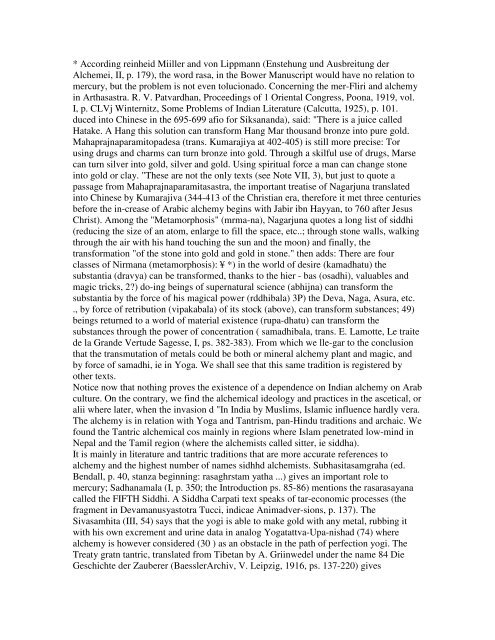Mircea Eliade YOGA IMMORTALITY AND ... - Brihaspati.net
Mircea Eliade YOGA IMMORTALITY AND ... - Brihaspati.net
Mircea Eliade YOGA IMMORTALITY AND ... - Brihaspati.net
Create successful ePaper yourself
Turn your PDF publications into a flip-book with our unique Google optimized e-Paper software.
* According reinheid Miiller and von Lippmann (Enstehung und Ausbreitung der<br />
Alchemei, II, p. 179), the word rasa, in the Bower Manuscript would have no relation to<br />
mercury, but the problem is not even tolucionado. Concerning the mer-Fliri and alchemy<br />
in Arthasastra. R. V. Patvardhan, Proceedings of 1 Oriental Congress, Poona, 1919, vol.<br />
I, p. CLVj Winternitz, Some Problems of Indian Literature (Calcutta, 1925), p. 101.<br />
duced into Chinese in the 695-699 afio for Siksananda), said: "There is a juice called<br />
Hatake. A Hang this solution can transform Hang Mar thousand bronze into pure gold.<br />
Mahaprajnaparamitopadesa (trans. Kumarajiya at 402-405) is still more precise: Tor<br />
using drugs and charms can turn bronze into gold. Through a skilful use of drugs, Marse<br />
can turn silver into gold, silver and gold. Using spiritual force a man can change stone<br />
into gold or clay. "These are not the only texts (see Note VII, 3), but just to quote a<br />
passage from Mahaprajnaparamitasastra, the important treatise of Nagarjuna translated<br />
into Chinese by Kumarajiva (344-413 of the Christian era, therefore it met three centuries<br />
before the in-crease of Arabic alchemy begins with Jabir ibn Hayyan, to 760 after Jesus<br />
Christ). Among the "Metamorphosis" (mrma-na), Nagarjuna quotes a long list of siddhi<br />
(reducing the size of an atom, enlarge to fill the space, etc..; through stone walls, walking<br />
through the air with his hand touching the sun and the moon) and finally, the<br />
transformation "of the stone into gold and gold in stone." then adds: There are four<br />
classes of Nirmana (metamorphosis): ¥ *) in the world of desire (kamadhatu) the<br />
substantia (dravya) can be transformed, thanks to the hier - bas (osadhi), valuables and<br />
magic tricks, 2?) do-ing beings of supernatural science (abhijna) can transform the<br />
substantia by the force of his magical power (rddhibala) 3P) the Deva, Naga, Asura, etc.<br />
., by force of retribution (vipakabala) of its stock (above), can transform substances; 49)<br />
beings returned to a world of material existence (rupa-dhatu) can transform the<br />
substances through the power of concentration ( samadhibala, trans. E. Lamotte, Le traite<br />
de la Grande Vertude Sagesse, I, ps. 382-383). From which we lle-gar to the conclusion<br />
that the transmutation of metals could be both or mineral alchemy plant and magic, and<br />
by force of samadhi, ie in Yoga. We shall see that this same tradition is registered by<br />
other texts.<br />
Notice now that nothing proves the existence of a dependence on Indian alchemy on Arab<br />
culture. On the contrary, we find the alchemical ideology and practices in the ascetical, or<br />
alii where later, when the invasion d "In India by Muslims, Islamic influence hardly vera.<br />
The alchemy is in relation with Yoga and Tantrism, pan-Hindu traditions and archaic. We<br />
found the Tantric alchemical cos mainly in regions where Islam pe<strong>net</strong>rated low-mind in<br />
Nepal and the Tamil region (where the alchemists called sitter, ie siddha).<br />
It is mainly in literature and tantric traditions that are more accurate references to<br />
alchemy and the highest number of names sidhhd alchemists. Subhasitasamgraha (ed.<br />
Bendall, p. 40, stanza beginning: rasaghrstam yatha ...) gives an important role to<br />
mercury; Sadhanamala (I, p. 350; the Introduction ps. 85-86) mentions the rasarasayana<br />
called the FIFTH Siddhi. A Siddha Carpati text speaks of tar-economic processes (the<br />
fragment in Devamanusyastotra Tucci, indicae Animadver-sions, p. 137). The<br />
Sivasamhita (III, 54) says that the yogi is able to make gold with any metal, rubbing it<br />
with his own excrement and urine data in analog Yogatattva-Upa-nishad (74) where<br />
alchemy is however considered (30 ) as an obstacle in the path of perfection yogi. The<br />
Treaty gratn tantric, translated from Tibetan by A. Griinwedel under the name 84 Die<br />
Geschichte der Zauberer (BaesslerArchiv, V. Leipzig, 1916, ps. 137-220) gives







